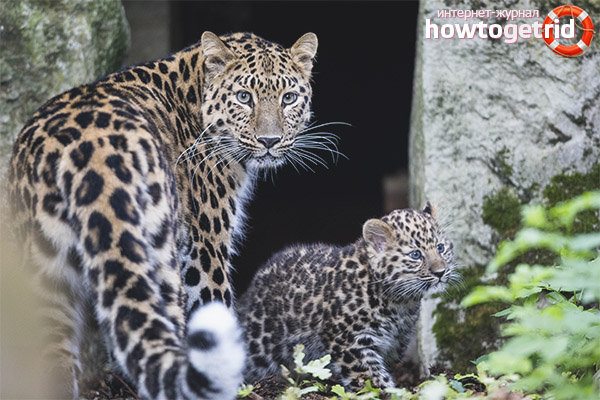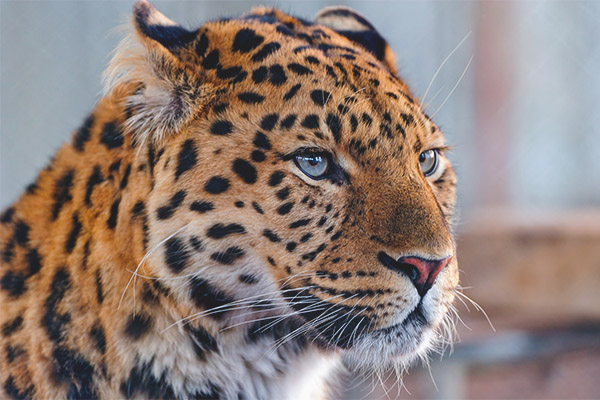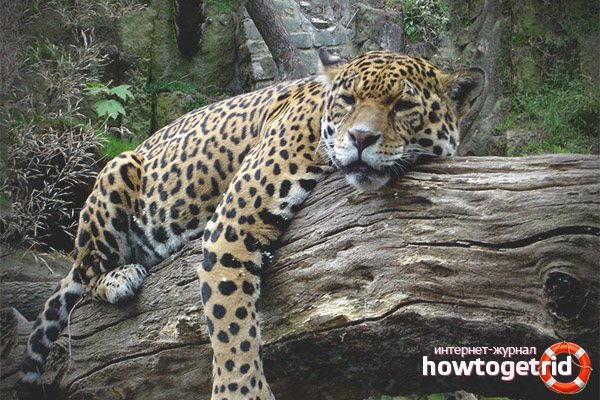The content of the article
Most often, when people imagine a leopard, they have an association with African savannas. Despite this, the very north of the habitat of this animal falls on the Far Eastern part of Russia and the northern part of China. Such a reason led to the fact that this predator has the name “Far Eastern leopard”. However, this same beast bears the name of the Amur leopard or leopard.
The Amur leopard is included in the Red Book, being an endangered animal, balancing on the verge of extermination. The reason for this is not only the colossal loss of habitat, but also a variety of conflicts with people. Thus, the Amur leopard population is experiencing rather difficult times.However, there is a possibility that the subspecies can be saved, since the “colleague” of the Far Eastern leopard, the Amur tiger, managed to increase the number of heads in the population, although half a century ago there were about 40. It is believed that the Amur leopard can be saved if timely implement conservation projects.
Animal description
The leopard living in the Far East, on a number of features differs from all other individuals belonging to the feline family. In summer, its wool can reach 2-3 cm, and by the onset of cold weather it can grow up to seven centimeters. On the other hand, in winter the wool has a light shade, with some patches of yellowish-red, and in warm periods it is more saturated. Also, in comparison with its other brethren, the Amur leopard has stronger and longer limbs, allowing it to move freely in the snow. The body weight of an adult male is approximately equal to 47 kg, but sometimes it is possible to meet larger animals, whose weight can reach 62 kg. Females usually weigh no more than 40 kg.
The body of the Far Eastern leopard is graceful, elongated and slender. The tail of the animal is straight, even and fairly long.Limbs muscular, strong, head has a rounded shape. Nature seemed to have "deliberately" presented the Far Eastern leopard with such a long tail, which now allows it to maneuver confidently while jumping from steep cliffs.
The neck of this predator is incredibly powerful, this is what gives him the opportunity to grab the victim and then drag it along with it, even though it may be bigger and heavier than him a couple of times.
Habitat
The Amur leopard predominantly lives in sparse forests, in areas where heavy precipitations fall, and the temperature range is quite extensive. At present, the total area occupied by the Far Eastern leopard is approximately 5 thousand square meters. m
The Far Eastern leopard clearly prefers forests where cedars, fir and larch grow. For the comfortable existence of the Amur leopard, it is necessary to populate the territory where there are steep hills, water bodies, the relief is crossed, there are outcrops of rocks.
Population size
According to official estimates, no more than 25 individuals currently live in the wild.All Far Eastern leopards occupy a small area, which is located on the border between China and Vladivostok. On the territory of China itself, there are about 8-11 adult viable leopards. The last message about a meeting with a Far Eastern leopard in South Korea dates back to 1969, when an animal was caught near Oda Mountain, which is located in Kensan-Namdu.
The history of the distribution of the Amur leopard
At this point, it can be argued that the distribution of the population has been extremely reduced relative to its original historical habitats. In former times, this stately animal occupied the entire northeastern part of Manchuria, including the province of Jilin and Heilunjiang, as well as the Korean p / o.
Social behavior of individuals
The Far Eastern leopard is prone to be alone, going hunting at night, and resting during the day. However, there are many cases where the males remained together with the female after mating had already taken place, and even assisted her in raising and searching for food for the offspring. Also, it often happens that several adult males look after one female, fighting among themselves for the opportunity to mate with her.
Breeding features

The Amur leopard reaches sexual maturity by the age of three years. In a wild habitat, an animal can live for about 13 years, on average. When kept in zoos and aviaries, the lifespan is extended to twenty years. The time of marriage rituals at the Amur leopard falls on the first month of summer or spring.
One female in the litter has one to four cubs. Kittens are born completely blind, their skin is already spotty, warm. The fur is silky, sockets are not formed. Their weight barely reaches 700 grams, the length of the body is about 15 cm.
When they are about three months old, the baby leaves the mother's milk. The beast becomes fully independent by the age of one and a half to two years of life and can leave its mother in order to continue to live alone.
Feeding the Far Eastern Leopard
The diet of the animal includes badgers, roes, small wild hares or wild boars, deer and raccoon dogs. In some cases, the predator can attack large birds of prey.This beast has a sharp vision, it allows him to see his victim at a great distance, up to one and a half kilometers.
In addition, they can climb the trunks of trees, so even raccoons can not escape from them. It is curious that the Far Eastern leopard only needs to catch only one spotted deer, and this will allow it to live comfortably for the next 10 days, so during this period the predator does not pay attention to other animals that are included in its diet.
Threat of existence
The majority of the natural habitat was lost by the Amur snow leopard from 1970 to 1983. The list of the main causes of the incident includes random forest fires, the formation of agricultural land and the forest industry. However, the joyful moment is that the situation can still improve. At present, there remains a sufficient area of forest area, which is quite suitable for the life of the Far Eastern leopard. Such a territory can still be protected from the harmful effects of humans and expand the population of the animal in the wild.
The overwhelming majority of the population currently lives in reserves and nurseries. In the wild, unfortunately, there are already quite mature individuals that are unlikely to be able to produce strong and viable offspring.
Production shortage
In China, there are lands with a large area where the Far Eastern leopard can live comfortably, but the main problem is that the food supply in this area is too scarce, it simply is not enough to maintain the large population at the right level.
The amount of small living creatures that are included in the diet of an animal can be increased if the use of woodland by the population living in close proximity to them is qualitatively and timely resolved. In addition, it is necessary to introduce effective measures to protect ungulates from the actions of poachers. In order for the Far Eastern leopard to survive, it will need to re-populate the area, which had once been its habitat.
The problem of poaching and illegal trade
For a long time the Amur leopard has been pursued by poachers who hunt for its magnificent fur, adorned with spots.At the very end of the twentieth century, law enforcement officers conducted a major experiment. The skin of two Amur leopards was artificially recreated, which were later sold for a large amount of sun. Barabash, which is located close to Kedrovaya Padi, is one of the reserves located in Russia.
The success of this experiment once again proves that there is a large amount of illegal markets in which products of this kind come true from the places where the population of protected animals lives. Spacious agricultural areas and small settlements surround the woodland where Far Eastern leopards live. Thus, a person has direct access to the forest. Due to this, poaching turns into a truly major problem, rather than in areas remote from human access. It is also worth noting that this is a common problem, as it affects not only the population of the Far Eastern leopard, but also a number of other animals that are being killed by aborigines in order to get meat and money.
Conflict with man
The Far Eastern leopard has a high level of vulnerability, because a certain percentage of their diet consists in animals such as deer.In the Far Eastern part of Russia, the population of deer has significantly decreased, since in Asian medicine deer horns have a high value. Thus, it becomes a serious obstacle for the leopard in obtaining the required amount of food.
The lack of food leads to the fact that the Far Eastern leopard often visits the sites where the reindeer herding is located. It is natural that the owners of this area in order to protect their own animals sometimes kill the Amur leopard.
Inbreeding
In addition to all of the above, another common problem is the low population of the Amur leopard, as such. The bottom line is that the low number of animals makes the entire population extremely vulnerable and prone to various natural phenomena or disasters.
This could include sudden and extensive fires in wooded massifs, certain diseases, a violation of the ratio between the birth of offspring and mortality of individuals. It also happens that for a certain number of years males are predominantly born in the offspring, therefore, the sex ratio is disturbed. Another factor is the so-called inbreeding depression.In the population of these animals, there are often related relationships of a related nature, so it is quite possible that genetic faults could be the result of this, which could also include a decrease in the birth rate.
According to the research, in the period from 1973 to 1991, the average number of leopards born in offspring fell from 1.9 to 1, respectively.
Video: Far Eastern leopard (Panthera pardus orientalis)












To send